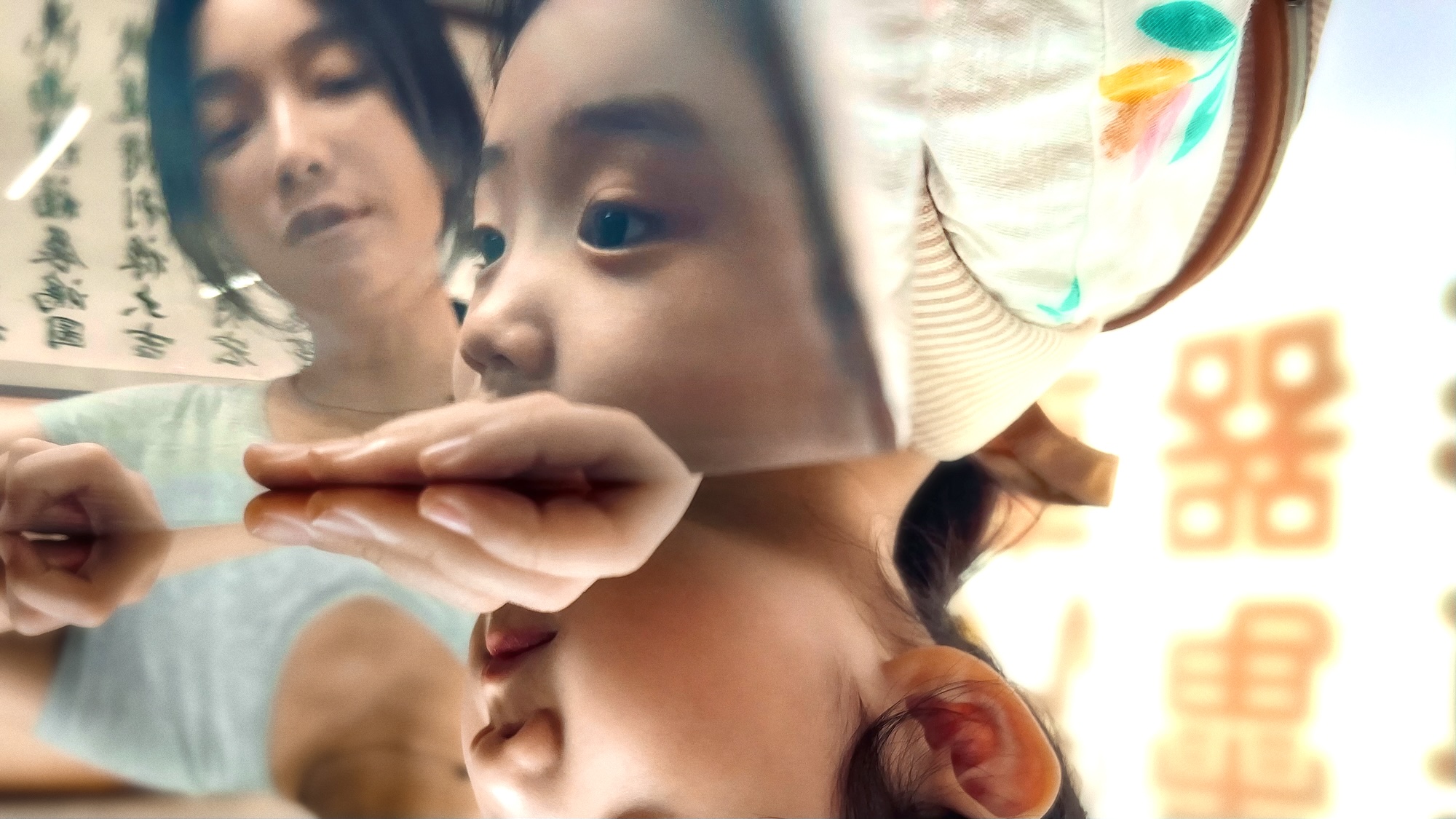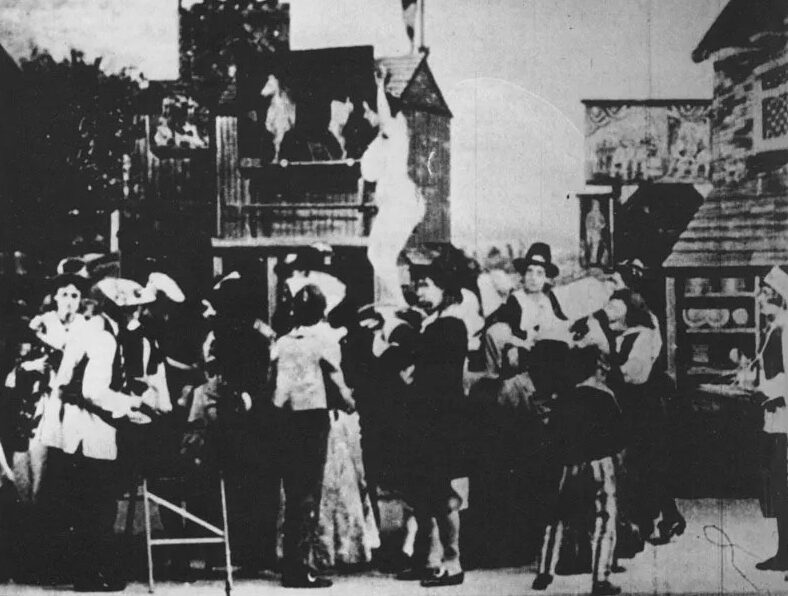
Two much-ballyhooed new releases arrive this week, but I was more taken with a lower-profile film that is Taiwan’s submission for Best International Feature consideration at the Oscars this year. Left-Handed Girl is the first solo feature directed by Shih-Ching Tsou, who co-directed a strong NYC immigrant drama (Take Out) two decades ago with Sean Baker, and since has produced several of his movies, including the breakouts Tangerine and The Florida Project. He co-wrote and edited the long-aborning Girl, which was apparently in the works at least as early as 2012, delayed by funding issues. Hopefully its stellar reception to date will mean a much shorter wait for her next project.
After living in the countryside for several years, Shu-Fen (Janet Tsai) is returning with her two daughters to Taipei, where her own parents still live. The latter aren’t a great help, though, as the grandmother (Xin-Yan Chao) is a self-absorbed materialist mostly focused on some dubious international smuggling “work,” while the grandfather (Akio Chen) is a grumpy layabout whose superstitious values seem frozen in some distant past. Having long carried the burden of an estranged ex-husband’s debts, Shu-Fen hopes to get ahead financially at last by operating a noodle stand in a busy night market.
Her adult daughter I-Ann (Shih-Yuan Ma) is a sullen looker who dresses like Sunset Strip jailbait in a 1970s drive-in movie. She finds employment at a betel-nut shop where she’s duly expected to flirt with the leering male customers—and perhaps deliver more extensive favors to the skeevy owner (Teng-Hung Hsia). Jaded as she already is, the city seems more likely to take advantage of I-Ann than vice versa.
On the other hand, Taipei in general and the market in particular seem an endlessly exciting playground for little I-Jing (Nina Ye), I-Ann’s much younger sibling. While we might fear for the safety of a grade-schooler running around such an environ, area merchants all seem to keep her within their benevolent gaze, including the handsome hawker (Brando Huang) who shyly tries to court her mother. Left-handed I-Jing is gullible enough to be disturbed, however, when the thoughtless grandfather impresses on her that being a southpaw is “the devil’s work.” She interprets that literally, believing she has no control over that “evil” extremity—giving “it” license to compulsively shoplift around the ‘hood.
Goosed by the market’s garish neon colors, Baker’s often frenetic editing and the hand-held iPhone cinematography of Ko-Chin Chen and Tzu-Hao Kao, Girl at first seems a dizzying gulp of pure urban atmosphere, almost overwhelming in its tactile nature and discordant character dynamics. But gradually plot threads emerge, along with deeper psychological insights. After a while we realize that Shu-Fen’s self-sacrifice and grueling work ethic have long stamped her as a “loser” in the eyes of her entire family, including several more-prosperous sisters. But they’ve all suffered so the grandparents can indulge their sole brother, a noxious “little prince” whose assumed superiority is based on nothing more than gender. We don’t meet him until the climax, an extended setpiece during grandma’s 60th birthday celebration. It’s the kind of affair in which you know all simmering tensions are going to explode in the ugliest (if also funniest) way possible… as indeed they do.
A key revelation that greatly escalates the eventual chaos there seemed unnecessary to me—Left-Handed Girl already has enough on its plate without need for that particular soap-operatic twist. But otherwise, this is (like many of Baker’s own films) a fine example of a narrative that seems more attuned to detail than a storytelling arc, until magically it all pulls together to a sharp, unified point. Not least of its satisfactions is that by then just about everybody onscreen has acquired more dimensions than initially detected. Shrill, seemingly shallow I-Ann turns out to be especially full of surprises, as well as solid reasons for discontent. It’s an ultimately delightful and touching movie that at its abrasive outset looks hardly likely to be either. At the time of writing, Left-Handed Girl was playing limited theaters (including SF’s Opera Plaza), but it also begins streaming on Netflix this Fri/28.
The much bigger awards-bait releases are both opening in theaters this Wed/26. Currently favored (even above One Battle After Another) to sweep various prize categories is Hamnet, Chloe Zhao’s adaptation of the best-selling historical novel by Maggie O’Farrell. It posits young William Shakespeare (Paul Mescal) as the bane of his own family in 16th-century rural England. They—in particular his brutish father, a leatherworker—consider his education a waste, as he demonstrates little aptitude for anything but scribbling…and it will take some time before that pursuit translates into anything lucrative. Will falls in love with Agnes Hathaway (Jessie Buckley), a neighbor whispered about as a “witch” for her woodsy, herbalist ways. Knowing their families will oppose the match, they force the issue by conceiving a child. These earlier sections of the two-hour film are quietly rapturous: Everyday period life is evoked convincingly, without excess grunge or prettification, and the passion between the two is likewise conveyed with a direct, potent simplicity.
They eventually have three children, including twins Hamnet (Jacobi Jupe) and Judith (Olivia Lynes). But when illness takes away one of those lives, Zhao—whose admirable prior films including The Rider and Nomadland also were less dependent on plotting than feeling—trusts overmuch that the buildup has sufficiently prepared us to wallow in the leading characters’ grief. This becomes one of those enterprises that assumes the more crying, screaming, moaning et al. the performers do in closeup, the more intense the emotional experience will be for viewers.
Sponsored link
But for me, it soon became overkill and actor indulgence, despite Buckley’s formidable skill. There is something about her that lacks conventional movie-star polish and artifice, making her seem more relatable, the emotions expressed more raw. Still, Hamnet becomes a dirge of histrionic mourning, partly because we don’t fully understand Agnes’ anger at her husband (she’d previously been fine with his spending a great deal of time in London, building his stage career), or why their surviving kids bring so little comfort. It doesn’t help that as Hamnet, Jacobi Jupe has the slightly off-putting manner of a child performer whose effects already seem too precociously calculated.
His real-life older brother Noah, who was very good as teenage Jesus in The Carpenter’s Son earlier this month, is fine again as Hamlet—the first performance of that play comprising this film’s climax. It’s a good one, even if there’s something a bit basic in the notion that it serves as “drama therapy” for both author and mother, channeling their grief into a fictive form. (It’s also weird that we’re meant to believe Agnes has seemingly never seen a play before, despite Hamlet coming right in the middle of her spouse’s approximately two-decade career.) Zhao does pull off that sustained final set-piece, and the response from other critics and early audiences suggests there will be nary a dry eye in the house. But much as I wanted to love Hamnet, after a point it felt forced.
Also opening in theaters the day before Thanksgiving (then going to Netflix on Dec. 12) is Wake Up Dead Man, the latest Knives Out mystery from writer-director Rian Johnson. I didn’t much like the prior two, which struck me as glib, snarky imitations of Agatha Christie terrain—big on attitude, low on genuinely clever mechanics. But a whole lot of people enjoyed them greatly, as they probably will this third installment, though again (despite its strong early reviews), it didn’t work for me.
A pugnacious young priest (Josh O’Connor) assigned to a rural parish finds it being methodically choked to death by the monsignor (Josh Brolin) whose rather literal bully pulpit drives away any new potential worshippers. At the same time, his combination of favoritism and cruelty holds in thrall a small coterie of infighting loyalists played by Glenn Close, Jeremy Renner, Kerry Washington, Andrew Scott, Cailee Spaeny, Daryl McCormack, and Thomas Haden Church. When this holy terror gets killed under baffling circumstances, all of them seem suspect—although the situation appears rigged to frame poor newbie O’Connor. Mila Kunis plays the investigating local police chief, while after 45 minutes or so Daniel Craig finally turns up as sleuth Beniot Blanc.
Craig really hams it up here, perhaps in compensation for his character getting relatively little screentime. But the true lead is very busy British actor O’Connor. To his credit, he gives the film all the emotional heft it has, making something out of the only figure who’s not a quarrelsome stereotype. But at nearly 2.5 hours, Wake Up is overlong, over-contrived (the eventual flashback-laden who/whydunnit explanation is absurd), at once snide and pretentious. Johnson gives people windy speeches that amplify his own atheistic distrust of organized religion—which I’m fine with, being pretty much on the same page—in a self-congratulatory way. Then he turns around and waxes condescendingly pseudo-“sincere” about respecting other people’s faith. Many will no doubt be delighted all over again. But this smug contraption left me feeling curiously offended on the part of any Christian viewers… a response well outside my usual wheelhouse.

Worth noting are a couple very special revival shows around the city over the next week. On Tuesday Dec. 2 at Gray Area, San Francisco Cinematheque is honoring the legacy of an avant-garde titan who passed away last month at age 92. The “Remembering Ken Jacobs” (more info here) program includes 1964’s Window and the forty-years-later Mountaineer Spinning. But its centerpiece will be the feature-length work that remains his most famous, one that secured his place at the forefront of the structural film and found-footage-assembly movements.
1969’s Tom, Tom, the Piper’s Son begins with the unaltered entirety of an original 1905 short from pioneering silent studio Biograph Company, depicting a large cast acting out the titular nursery-rhyme tale in antic, acrobatic fashion on theatrical pasteboard sets. Then those 11 or so minutes are subjected to every kind of deconstructive attention, from freeze-frames and blowups to speed variations and reverse motion.
Speaking of legacies, the Cinematheque itself is in serious financial crisis due to the Trump administration’s decimation of National Endowment for the Arts funding. Having just lost about a quarter of its annual budget as a result, this esteemed local organization is at risk of going under on the brink of its 65th year in operation. You can help by becoming a supporting member, or making a tax-deductible donation, further info here.

Another SF institution is Lost Landscapes of San Francisco, which is celebrating its 20th anniversary with a new program assembled from 300 films—home movies, educational, industrial and promotional clips, et al.—drawn turn by Rick Prelinger from 128 years of moving images capturing the city by the bay. This Internet Archive presentation will play Wed/Thurs. Dec. 3-4 at Herbst Theater, tickets available here.
Source link

